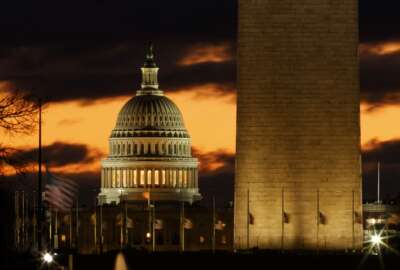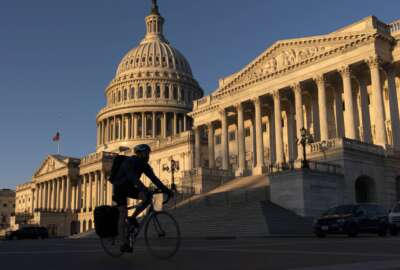
Congress cares about one thing now and its not 2023 appropriations
Congress trucks back to Washington this week with only a few legislative days left before the end of the fiscal year.
Best listening experience is on Chrome, Firefox or Safari. Subscribe to Federal Drive’s daily audio interviews on Apple Podcasts or PodcastOne.
Congress trucks back to Washington this week with only a few legislative days left before the end of the fiscal year. They’ll have to deal with government funding among other things. Here with the outlook Bloomberg Government deputy news director Loren Duggan, who talked to the Federal Drive with Tom Temin.
Interview transcript:
Tom Temin: Let’s begin with what’s the schedules precisely for the House and the Senate.
Loren Duggan: Well, the Senate’s back today, and they’ll be in for the next several weeks. The House doesn’t return for floor business until next week. This is officially a committee work week, which means we may see some hearings and some events like that, but we won’t see actual floor votes this week in the House. Then we have a very packed September with a few days off toward the end for the Jewish holidays, which will be starting, and then we head into October where business will largely quiet down on the House side. And there may be some business for a couple of weeks in the Senate. But the other date that’s circled on the calendar, you mentioned September 30, at the end of the fiscal year is of course, November 8, which is the elections, which is one of the reasons we’ll see fewer days in business for the next several weeks so that people can go home and campaign and try to win their jobs back for next year.
Tom Temin: Safe to say that they will not actually do detailed work on the twelve standard spending bills, but more of their time will be spent simply on the scope and shape of the continuing resolution?
Loren Duggan: That will be the big issue is how long to fund the government in this continuing resolution. And what to attach, as this was probably the last big bill moving before the election after all the larger pieces of legislation that they passed, obviously earlier this year. But this bill, whatever shape it takes will be a pretty high profile one and could be an attractive vehicle for a lot of things that they want to get through both on the administration side, authorities and money that they need. And then in Congress if there’s some priorities they want to tack on.
Tom Temin: Right, because the administration has proposed this 4.6% pay raise for federal employees. If Congress is silent on that it happens. And so they could either approve it by saying also 4.6%, maybe raise it or maybe lower it depending on who prevails.
Loren Duggan: Right? That’s correct. But with that may also be tabled for later in the year when they get to the larger appropriations bills. Because as you notice, as you noted, there are 12 normal appropriations bills that they would work on or try to pass. The House has passed six of the 12 and the others have come out of committee. On the Senate side, we’ve seen 12 bills released by Senate Democrats, although those weren’t ever voted on in any formal fashion. But we still don’t know yet what a final appropriations package will look like in part because there really haven’t been the bicameral bipartisan agreements you need to get moving toward that. So everything from federal pay to riders that normally have been in the bill and may not be going forward. All that is still very much up in the air because they just haven’t made progress.
Tom Temin: And in getting the yes vote they wanted from Joe Manchin, the Democrats that is, Senate Majority Leader Chuck Schumer said that when they came back, which is now, that they would get around to the permitting reform. The idea is that because of local, state, and to a great degree, federal permitting requirements for large infrastructure projects, part of the problem is how long it takes to get permits, is that something that could be attached to the CR bill or something like that?
Loren Duggan: That has been discussed. I’m not sure that everyone is quite sold on that idea yet. And this is something that will require a different type of support necessarily than what you had in that reconciliation deal that Joe Manchin agreed to that was very much a party line bill, only Democratic votes in both chambers and then the 50-50 Senate that meant all 50 members of that caucus plus Kamala Harris, the Vice President. So this idea may not pass muster with all the Democrats, but it may attract some support from Republicans. So we’ll have to see what that final permitting deal looks like, what’s in it, what kind of support it can pick up because in the House, if you need every Democrat, then that permitting language may not be attractive if you’re trying to pick up Republican votes, which you need in the Senate where it takes 60 votes to get things done, and you need 10 Republicans to side with you, when you craft this continuing resolution, then it could be attractive there. So that’s definitely dynamic. We’ll be watching. Can Joe Manchin get these side deals signed into law after his success in getting the big bill passed through Congress and onto the President’s desk back in August?
Tom Temin: We’re speaking with Loren Duggan, deputy news director at Bloomberg Government. And by the way, what’s the status of the National Defense Authorization Act (NDAA)? They are proud of always getting that done. But that’s more a calendar than a fiscal issue for Congress?
Loren Duggan: For the most part, most of those authorities run throughout the year. And you know, if they needed to extend something imminently in the continuing resolution, they do so but the House has passed its version of the bill, the Senate Armed Services Committee has sent out its version to the floor and it’s available for action, not clear if we’ll see that right away in September. If that’s something that will happen later in the year, that six decade plus streak that they have of signing that into law, I don’t think that’s at risk of being broken. I don’t think any armed services chairman on any side of the House or Senate wants to be the one who breaks that streak. So I would see maybe more behind the scenes action potentially some votes in the Senate, but that will really be a goal I think in that lame duck post-elections session to get the final version together and over to President Biden by the end of the year.
Tom Temin: And the camp followers that look at what is in each year’s NDAA for federal procurement and defense procurement policy. There’s not a whole lot there this year. This seems to be more of a quiet NDAA from that standpoint.
Loren Duggan: I mean, most of the fight this year so far has been about funding and how much to authorize in this bill. Both chambers came in well above what President Biden wanted, which will mean more money, obviously, for federal contractors and for agencies, because if they fund the programs through the appropriations bill, at the level in the authorization bill, there would obviously be more money there. But there’s always fights over riders and what to attach to it. I think we’ll probably see some discussion still about what to do in Guantanamo Bay and places like that. That’s not a settled matter, between the two bills. But for the most part, like you say, it’s not the biggest, it’s not, it’s not one of the contracting reform years, maybe some small changes here and there to some programs.
Tom Temin:
What about judicial picks? And are there any key nominations that we might see from the Senate as it gets back to work? It’s kind of late in the first term for people who maybe want to continue to be nominated. But nevertheless, you got to have people in place?Loren Duggan: Well, this is one where I think the election dynamic is coming into play. Democrats have their majority right now. And they want to use it, they want to get through as many of the President’s picks as they can. So the votes that they scheduled for this comeback week already are two judicial nominations, I think the seventh circuit and the sixth circuit, so they’ll process those. They’ll be looking for more picks, the president keeps nominating judges and Senate Judiciary Chairman Dick Durbin is doing his best to process those. There are still some administration positions open. I think Cathy Ann Harris is still waiting for her chairmanship vote to be approved. She was obviously confirmed to the board. And then there’s ambassador positions and other departmental slots that have come open and need to be filled. So this is going to be a busy part of the Senate’s agenda churning through these nominations at the committee and floor level, to try and fill the administration and get as many people as they can in case the Democrats do lose their majority later this year, and would have to make arrangements between a Democratic president and a Republican Senate.
Tom Temin: And beyond the time when they leave for the break in late September, and then they come back in early October, they’re still have a couple of months in the calendar year. Does anything happen then in a election year like this? Or is it going to be pretty much whatever they get done in this next couple of weeks is going to be basically it for the year? Except for that NDAA vote.
Loren Duggan: I think that the lame duck could be busy. There are things that both parties may want to get done. There’s people who’d like to cement their legacies before they leave retiring chairman and retiring members who might try to make arrangements. They’re still interested in doing some things on same sex marriage., in light of the Supreme Court ruling on abortion. There’s, you know, there’s a longshot push to do something about cannabis legalization or decriminalization, or at least maybe the part about banking. So there are a lot of priorities that people have. There’s a look still at changing the Electoral College Act from 1887, to update it in light of what happened in 2021. So a lot of members have a lot of things on their to do list. Sometimes after the election, it’s a little easier, things are a little quieter. And there’s a rush to get things done before they wrap up for the year. So that could be an actual fertile period. for things to get done.
Tom Temin: Right. The Electoral College was a bipartisan type of gambit in the first place.
Loren Duggan: Right. And that’s I think, Sue Collins, and again, Joe Manchin have their bill over bills, I believe it is over in the Senate, there’s a house push to write something there and to see what they can do. It may actually be easier, some people think, to get that done after the election when the pressure of the midterms is off. But try to get it done before this Congress wraps up by January 3 of next year.
Tom Temin: Lauren Duggan is deputy news director at Bloomberg Government.
Copyright © 2025 Federal News Network. All rights reserved. This website is not intended for users located within the European Economic Area.
Tom Temin is host of the Federal Drive and has been providing insight on federal technology and management issues for more than 30 years.
Follow @tteminWFED





